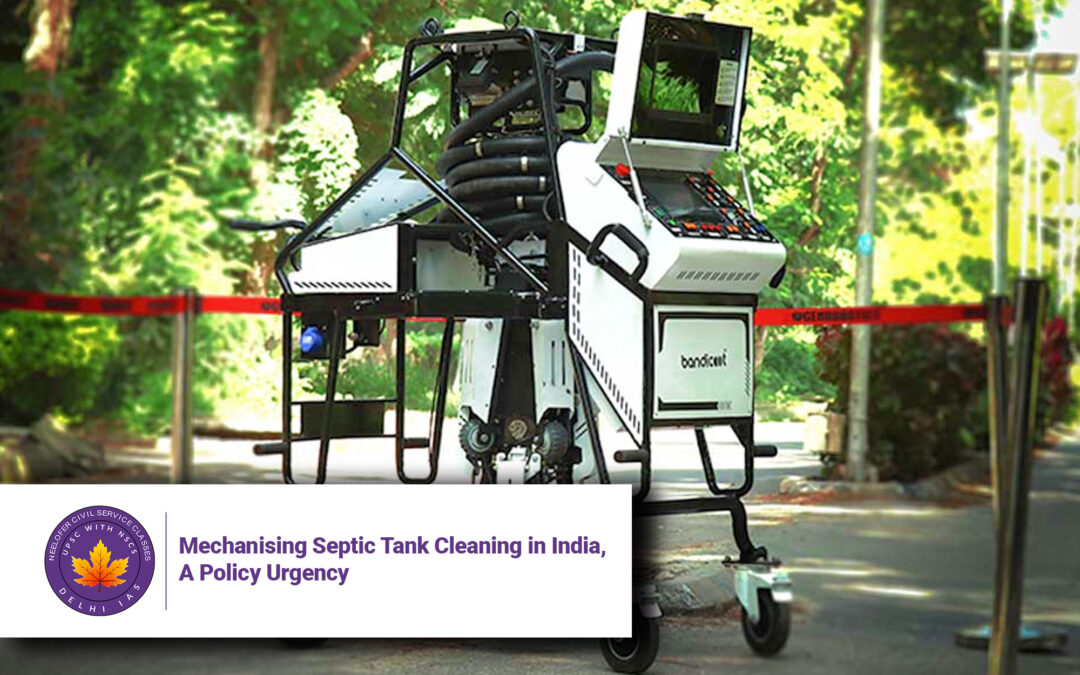Mechanising Septic Tank Cleaning in India, A Policy Urgency
Why in News?
The Ministry of Social Justice tabled a report in Parliament highlighting the deaths of 150 individuals due to hazardous septic tank cleaning in 2022 and 2023. This alarming situation has reignited the debate on fully mechanising sewer cleaning and ensuring the dignity and safety of sanitation workers. 
Introduction
Despite several laws and initiatives, manual scavenging and hazardous cleaning of septic tanks continue to claim lives in India. The government’s recent audit revealed structural flaws and administrative loopholes in implementing safety and rehabilitation measures for sanitation workers.
Key Issues and Institutional Concerns
-
Human Casualties & Exploitative Hiring:
Out of the 150 people who died during septic tank cleaning, only 5 were on government payrolls, while 38 were employed by local contractors. Many were public sector workers “loaned” to private employers, creating accountability gaps. -
Lack of Protection & Training:
A 2024 Parliament reply stated that 57,758 workers are involved in hazardous cleaning across India, but only 16,791 PPE kits were supplied. Less than 14,000 workers had health cards, and just 837 safety workshops were held across 4,800 urban local bodies. -
Insufficient Implementation of NAMASTE Scheme:
The 2023 National Action for Mechanised Sanitation Ecosystem (NAMASTE) scheme has had poor execution. Only ₹14 crore has been released so far—insufficient to mechanise sewer cleaning in even a single major city.
Positive Developments
Some states have shown progress:
-
Odisha: Provided PPE kits and mechanised desludging vehicles.
-
Tamil Nadu: Piloted sewer robots in Chennai, cleaning over 5,000 manholes.
Challenges and the Way Forward
-
Enforcement Issues:
Industry experts claim that most underground infrastructure can be cleaned robotically, yet manual bids still dominate government tenders. -
Lack of Support & Compensation:
In case of worker deaths, police often classify them as accidents or penalize lower-level staff. Supreme Court directives to cancel offending contracts and impose monetary penalties are not uniformly implemented. -
Rehabilitation Gaps:
Most validated workers are Dalits, but they rarely receive comprehensive rehabilitation packages such as housing or scholarships. Women who clean dry latrines remain largely ignored in policy. -
Policy Recommendations:
-
Make sewer cleaning a licensed trade.
-
Mechanisation should be mandatory and linked with rural and urban Swachh Bharat budgets.
-
Penalise non-certified manual operations.
-
Upscale loans for purchasing cleaning equipment.
-
Extend NAMASTE scheme to gram panchayats.
-
Conclusion
Septic tank cleaning must be completely mechanised across India to stop preventable deaths and restore dignity to sanitation workers. A combination of strict enforcement, adequate funding, and inclusive rehabilitation is essential to address this long-standing issue.
Q&A Section
Q1. How many sanitation workers died during septic tank cleaning in 2022 and 2023?
A: 150 people died, according to a Ministry of Social Justice audit.
Q2. What is the NAMASTE scheme?
A: It stands for National Action for Mechanised Sanitation Ecosystem, aiming to mechanise hazardous sanitation work.
Q3. Which states have shown positive results in mechanised sanitation?
A: Odisha and Tamil Nadu. Odisha distributed PPEs and vehicles, while Tamil Nadu used robots to clean manholes in Chennai.
Q4. What are the main issues with the current system?
A: Lack of PPE, poor enforcement, insufficient rehabilitation, and continued manual bidding in tenders.
Q5. What policy changes have been suggested?
A: Mechanisation of sewer cleaning, legal penalties for manual operations, upscaling equipment loans, and extending the NAMASTE scheme to rural areas.








